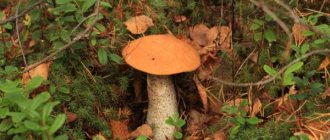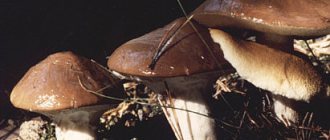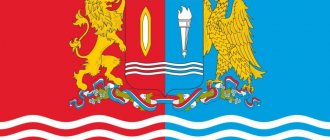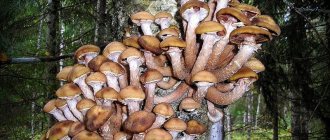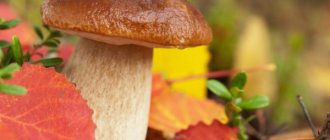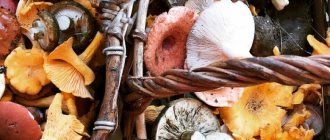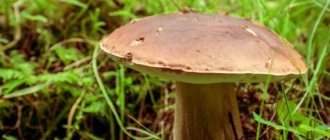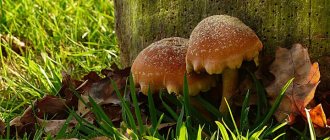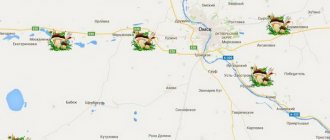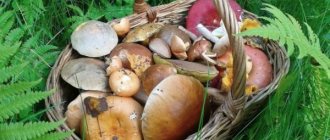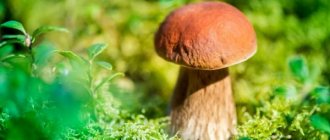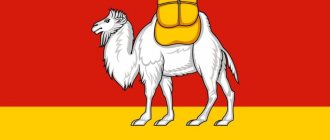The Kaliningrad region is an amazingly beautiful region, famous for its mushroom places. For mushroom pickers, there is plenty of freedom here - the “assortment” of mushroom gifts allows you to thoroughly enjoy the “quiet hunt”. Thanks to favorable climatic conditions, artificial cultivation of mushrooms is widely practiced in the region. In addition to the well-known champignons and oyster mushrooms, other edible mushrooms that are in demand among consumers can be safely grown in this area.
The most mushroom places in the Kaliningrad region
The list of places and settlements most frequently mentioned by mushroom pickers, in the vicinity of which they had good luck, was compiled based on the results of messages from participants in thematic forums and groups on social networks over the past few years.
Useful material: how to profitably sell surplus mushrooms.
The central part of the region and the outskirts of Kaliningrad:
- forest in the area of the city cemetery (behind the village of A. Kosmodemyansky);
- Lublin forest (region Lyublino, Logvino, Cherepanovo, Pereslavskoye);
- Konstantinovsky forest (Ryabinovka railway station).
Western part of the Kaliningrad region:
- Shipovka, Vzmorye, Volochaevskoye, Izhevskoye;
- Baltic forest;
- Baltic Spit;
- Kumachevo, Kruglovo.
What mushrooms grow in Kaliningrad.
Southwestern and southern part of the region
- Ushakovo;
- Pyatidorozhnoe;
- Ladushkinsky forest (Ladushkino, Sosnovka, Novomoskovskoe);
- railway station Sosnovy Bor;
- “Devil's Bridge” on the Berlinka (Zvonky Forest);
- Strelnya;
- Medovoe, Kornevo, Kornevsky forest, Domnovo, Ilyushino, Pogranichnoe.
Southern and southeastern part of the region, area of the Pravdinsky test site:
- Komsomolsk, Ozerki;
- Znamensk;
- Semenovo, Semenovsky, Ozersky;
- Gvardeisky, Znamensky forests;
- Mushrooms, Armyskoye, Tumanovka, Sosnovka, Mariskoye, Chekhovo, Tishino, Druzhba;
- Kashtanovka;
- Peasant forest.
Mushrooms in the Kaliningrad region.
East End:
- Zorino, Pushkarevsky, Pushkarevsky forest;
- Zhavoronkovo, Mezhdurechye;
- Gremyache, Pastukhovo, Pastukhovsky forest, Zeleny Bor;
- Red Forest, Krasnolesye, Lake Vishtynets.
Northeast:
- Krasnoznamensk;
- Novoderevensky forest;
- Big Hills;
- Bolshakovsky forest.
North of the Kaliningrad region, direction to Polessk, Zelenogradsk, Svetlogorsk:
- Great Moss Swamp;
- Polesie forest;
- Sosnovka;
- Gromovo;
- Zalesye;
- Soldatovo;
- Krasny Bor;
- Red,
- Curonian Spit.
Before you go on a “silent hunt”, you should familiarize yourself with the recommendations of the Ministry of Emergency Situations.
Where honey mushrooms grow in Kaliningrad.
Where to collect saffron milk caps
These cheerful orange mushrooms appear in the forest closer to September. Ryzhiki are incredibly tasty and aromatic when pickled (unlike volushki, they do not require soaking), although some prefer to cook “fried” from them. You should look for saffron milk caps in spruce forests growing on the slopes of wide ravines, or under young pines on high hills.
Saffron milk caps love young coniferous trees and sandy soils, so you can go for them to the forests of the Curonian and Baltic forestry enterprises. These mushrooms are also found in the mixed forests of the Krasnoznamensky timber industry enterprise and near the city of Nesterov. In the northeastern region of the region, along with Krasnoznamensk, Novoderevensky Forest, Bolshie Gorki, and Bolshakovsky Forest enjoy a good reputation among mushroom pickers.
The most distant Vishtynets
According to mushroom pickers, the best chance of finding mushrooms is in the east of the region, closer to the Lithuanian border. According to avid quiet hunters, Vishtnynetsky Park is especially rich in mushrooms. It is located 175 kilometers from Kaliningrad. By the standards of residents of the regional center, this is a fairly decent distance. Therefore, not many people are willing to spend six hours just on the road for mushrooms.
In principle, the same harvest can be harvested closer to the east of the region. Near Chernyakhovsk, Gusev or Ozersk. Under the same Krasnolesye, mushroom pickers usually collect more than one basket.
But the result will certainly justify itself. In a good season, you can collect a trunk full of porcini mushrooms, honey mushrooms, boletus, boletus and other noble mushrooms.
Note that the Kaliningrad mushroom is capricious and very cunning. It is important to know not only where to go, but also when. Even the most successful “silent hunters” sometimes fail on their “secret” paths.
Where do milk mushrooms grow?
Milk mushrooms are the “most Russian” mushrooms, because abroad they are simply considered poisonous. Even the name of these mushrooms has deep Slavic roots (“gruzdie” means heap). Milk mushrooms really grow in “heaps”: a whole family lines up in the clearings of mixed forests, under young birch trees.
Milk mushrooms, like saffron milk caps, are usually pickled, but they require much more attention. First you need to soak them, then rinse them, change the water, then add water again... After two or three days, the mushrooms can finally be salted, but the “product” will only be ready two months after preparation. But these mushrooms have an enviable shelf life - black milk mushrooms retain their taste for three years.
Where do milk mushrooms grow?
Boletus, boletus and white boletus
Of course, the crystal dream of any mushroom picker is to find a clearing of porcini mushrooms. But, alas, boletus mushrooms are not always found, but there is a great chance along the way to collect a solid harvest of strong boletus and boletus mushrooms. These mushrooms are not so fancy (noble white mushrooms grow only in old forests at least 50 years old), but their taste and aroma will please any gourmet. Boletuses, boletuses, and white boletuses also love light mossy meadows, forest edges, birch and mixed forests.
Material on the topic: How to properly collect mushrooms without damaging the mycelium.
In search of mushrooms, you don’t have to go far from Kaliningad: you can go to the Shipovsky forest. They say that a lot of mushrooms grow near Polessk, as well as near the villages of Kosmodemyansky, Bolshoye Selo, and in the Soviet forestry. A white harvest is promised in the forests near the village of Shepetovka.
Mushrooms from the forests of the Kaliningrad region.
Edible mushrooms
The mushroom season in the Kaliningrad region lasts more than six months, starting in April and ending in the last days of November. Here mushrooms grow virtually everywhere - you don’t have to go into the forest to find them, because you can even find a couple in your own garden.
This region is divided into 4 key areas, where a special abundance of “gifts of the forest” is noted:
- The Neman Lowland, which includes the Slavskoye forestry industry, Ilyichevskoye and Polesye forestries. The region is distinguished by the presence of podzolic, peat, marshy and silt-marsh soils, on which black alder takes root well in significant quantities.
- Baltic and Curonian forests, which are distinguished by sandy soils. Along with regular winds from the sea, they create suitable conditions for the growth of mushrooms. In many cases you can find pine trees here. Birch and black alder grow in the lowlands, and oak, ash and hornbeam can sometimes be found.
- An additional region that is particularly favorable for the growth of mushrooms are the areas of the Nesterovsky forestry enterprise and the Krasnoznamensky forestry industry, which are distinguished by the diversity of their relief. The Nesterovsky district is dominated by a surrounding area with countless hills. Pine grows well on rocky soil. In areas with loamy soil, spruce and deciduous forests flourish.
- Other regions make up the fourth territory, which is rich in spruce and birch forests. Hornbeam, ash and oak trees are very common here, and black alder grows in the lowlands.
Mushrooms are divided into edible, conditionally edible and inedible, and also toxic. However, it is not always possible to get poisoned by an inedible species; at the same time, edible mushrooms, the rules of assembly, preparation or storage of which have been violated, can also lead to health problems.
There is no clear difference between edible and toxic species. Still, many toxic species - for example, fly agaric - are difficult to confuse with others.
The very sign of the pale toadstool and fly agarics is the presence of a volva, the remains of an outer shell, which at a young age covers the entire body completely, and subsequently forms a “pot” from which a leg grows. Mushrooms suitable for consumption are distinguished by the spongy structure of the cap, but many inedible ones have a lamellar cap.
In the Kaliningrad region you can find a large number of mushrooms, both classic and unusual. They are used to prepare soups, side dishes, appetizers, salads, and sauces. Mushrooms are fried, boiled, stewed, dried, pickled, and used in a variety of preparations for the winter. In addition, they are used in folk healing to treat and prevent many diseases.
boletus
boletus, also known as boletus, is one of the most beloved and widespread among the people. It has gained wide fame not only due to its noticeable, clearly recognizable appearance, but also because of its excellent taste. The boletus stands out for its rather large size: the cap is up to 25-30 cm in diameter, the stem is dense, and thick below.
The color of the cap depends on the area where it grows. In birch forests the cap has a light brown tint, in pine forests it acquires a purple tint, in spruce forests it becomes red-brown. The pulp is dense, elastic, white, and does not change color when cut.
The most convenient places for boletus to live are considered to be birch, pine and spruce forests.
Regular smoothie
There are many mixed forests in the Kaliningrad region that are favorable for smooth living. Their collection begins from the last month of summer to October. Smoothies can be identified by the distinctive purple-gray color of their cap. With age, the rings on the cap disappear, and the cap itself becomes yellow-red.
The leg is long and thin, thick at the bottom or in the middle. The white pulp is fragile and brittle; when pressed, an acrid juice is released, which turns yellow when in contact with air. Smoothies are perfect for pickling. But before that, they need to be soaked in salted water and boiled.
Milk mushrooms white, black
Milk mushrooms are readily collected only in our country - in the West they are considered inedible. But with proper preparation (primarily salting), milk mushrooms are not only edible, but also tasty. In the Kaliningrad region they are found everywhere: in birch, pine, spruce forests, in clearings, edges, etc.
The main varieties of milk mushrooms: white and black.
- A characteristic feature of the white ones is the milky white, sometimes yellowish coloring of the cap with very small spots and unique rings. The cap is up to 8 cm in diameter. The mushrooms are short, dense, and grow in groups. The pulp stands out with a strong structure; when pressed, the milky juice is released, which turns yellow in the air.
- Black milk mushrooms are characterized by a dark olive or black color. Sometimes they are also called nigellas. The leg is short, the cap has slightly curved edges, the plates are dirty green in color. The favorite habitat of nigellas is mixed forests. They can also be found in old foliage, mosses, and under branches.
Black milk mushrooms Milk mushrooms are wonderful when salted; So they can be stored without loss of taste for up to three years.
Dry forests are considered an excellent place for greenfinches to grow, where they settle in entire families. They begin to be collected at the end of the mushroom season, in the fall. They received their own name due to the yellow-green color of the cap - this color is preserved even during heat treatment.
Greenfinch has dense, slightly hard white flesh, which soon turns yellow. Under the cap there are delicate plates of various colors. It is recommended to boil, fry or marinate greenfinches. The main thing is that before any cooking they must be peeled.
Kozlyak is an ugly-looking mushroom, which at the same time has a rather pleasant taste. The cap with a diameter of 4-12 cm has a pale light brown color. In young representatives it takes on a spherical shape, later it almost completely straightens, becoming flat.
The leg is thin, curved, the same color as the cap. During rainy weather, the goat is covered with a thick layer of mucus, making its appearance even more unpleasant. The pulp is quite dense and has a good smell.
Goats should be looked for in swampy, damp places, in damp pine forests. Young mushrooms should be used for food. They are recommended to be fried, boiled, pickled or dried.
Small, bright and attractive foxes live in mixed, deciduous and pine forests, in clearings with grass or moss. Due to their remarkable appearance, they are difficult to confuse with other types of mushrooms.
Chanterelles are characterized by a funnel-shaped, wavy cap, covered below with fan-shaped plates, and a thin stalk up to 12 cm in height. They have a bright, yellow-orange color. The pulp is dense, juicy, retains freshness for a long time and, sometimes, is wormy.
Chanterelles are similar in taste to saffron milk caps and whitish mushrooms. They are delicious in any form: fried, boiled, stewed, pickled. They often become a means to treat various diseases.
Butterflies can be found virtually everywhere: in forests, clearings, forest edges, fields, paths, among the grass. Mushroom pickers collect the first harvest during the flowering period of the pine tree, the second - during the flowering period of the linden tree. However, the highest yields emerge during the grain harvest period.
Butterflies have caps of different colors, depending on where they live: from yellow and light brown to red-brown. Diameter 2-10 cm. The tubular layer located under the cap is covered with a white film, which later turns into a ring. The pulp is tender, yellowish, has a good smell with notes of fruit.
Butternuts are valued for their excellent taste, due to which they are widely used in cooking. They can be boiled and fried, salted and pickled. Butter stewed in milk has a particularly piquant taste.
In the post-Soviet countries, 7 types of moss mushrooms are popular; in this area green and yellow-brown (chestnut) are very common. Moss fly habitats include sandy soils, coniferous forests, thickets of trees with leaves, forest edges, and clearings.
- Green moss stands out with a large (3-12 cm), slightly convex cap of greenish or olive color, which is covered with very small scales on top. The leg is straight, long, slightly wider towards the top. The pulp is white.
- Chestnut moss It has a dark brown, chocolate or brown color, a dense and fleshy cap with scales, a cylindrical leg with a strong structure and a yellowish color. The pulp is yellow.
In two species, the cut flesh acquires a bluish tint, but this is not a sign of danger. It should be noted that there are no toxic flywheels or mushrooms similar to them. Moss mushrooms have a pleasant taste and are used for pickling, drying, and salting. They lend themselves very well to thermal processing in the form of frying, stewing or boiling.
Summer honey fungus
The main positive quality of honey mushrooms is that they grow in families and large groups. Summer honey mushrooms - or linden mushrooms, as they are also called - settle on rotten wood and trees.
The honey fungus is small in size; the cap can reach 3-6 cm, has a convex shape with a tubercle in the middle, around which circles are noticeable in damp weather. The leg is thin, up to 7 cm long, light on top, smooth, dotted with scales below. There is a ring on it in the form of a skirt, which may subsequently disappear.
Autumn honey fungus
Autumn mushrooms are larger in size. Their stem reaches 10 cm, and the girth of the cap is up to 17 cm. The cap has a convex shape, but becomes flat with age. Its base is covered with a layer of scales. Under the hat itself there is a skirt, painted white with a yellow border.
The color palette of the honey mushroom depends on the type of tree where it has settled: oak - brown, poplar - yellow with a honey visor, pine - brown-red.
boletus
During the flowering of viburnum, during haymaking, mushroom pickers go in search of boletus mushrooms, which grow most en masse in open areas, forest edges, field edges and birch forests.
The boletus stands out for its rather high size: the cap reaches 15 cm, the leg is long, dense, covered with dark scales. There are mushrooms of white, yellow or brown color. Boletus mushrooms are excellent for pickling. They are dried, fried or boiled.
Boletus
It is very easy to spot boletus in the forests. It is distinguished by a large round cap of orange, brown or white color, and also by a dense and long leg, thickened downward, its surface covered with scales. When cut, the flesh turns blue. Boletuses prefer to settle in mixed, birch and blueberry forests.
The collection of boletuses begins in July and ends with the first frosts. These mushrooms are used to prepare soups, stews, and added to vegetables. Also pickled and dried.
Polish mushroom
The chestnut mushroom is known in the Kaliningrad region under the name “Polish mushroom”. Its favorite places to live are pine forests with swamps, coniferous forests, and thickets of trees. It can also be found on soils where there is sand.
The Polish mushroom has a light brown, brown-chestnut or dark brown cap with a non-separable skin. After precipitation, the cap becomes sticky and slippery to the touch. The leg has a wrinkled yellow-tinged surface and a dense structure. When cut, the flesh turns blue.
Because chestnut mushroom has a pleasant taste, it is suitable for any type of processing: pickling, pickling, frying, etc.
Saffron milk caps, although they do not have a remarkable “appearance,” are loved by many mushroom pickers for their inimitable taste. They are collected in elevated areas among pines and spruces, starting in mid-August. The saffron milk cap is distinguished by its bright orange color and the presence of green spots on the cap.
Serushka or, as the inhabitants of these places called it, plantain, is a mushroom that grows in mixed and birch forests, near roads, on trails. Its characteristic properties are considered to be: a tight, gray-purple cap 4-10 cm with rings, a thin leg of the same color, fleshy flesh that releases milky juice when pressed.
Russulas were so named due to the fact that some of their types can be taken raw. Mushrooms are distinguished by their variety of colors: their cap can be all the colors of the rainbow. But the leg is white and hardy.
At a young age, the cap is convex, rounded, later it becomes flat or even funnel-shaped. The pulp is dense, spongy, white when cut. Russulas live in swampy areas, spruce-pine, and deciduous forests. They grow in groups and are not hidden in grass or leaves, making them easy to find even for inexperienced mushroom pickers.
However, they cannot enjoy enormous popularity due to their fragile structure. Certain types of russula have a bitter, burning taste, so before cooking they need to be soaked in cold water for 2 days.
